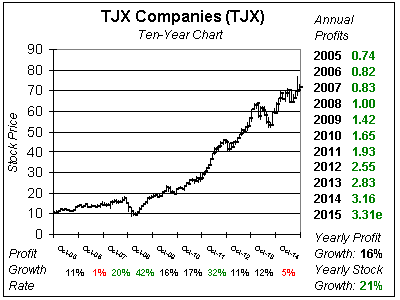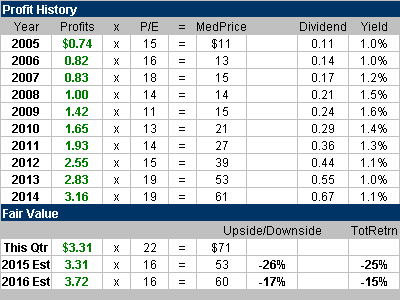TJX Companies (TJX) traces its roots back to 1956 when the Zayre discount department store was founded. The company opened its first T.J. Maxx in 1976 and sold the Xayre brand to Ames in 1988, and the company was renamed to The TJX Companies, Inc.
TJX is known for its T.J. Maxx stores, HomeGoods which it launched in 1992, and Marshalls which doubled TJX’s size when it was acquired in 1995. It is the only major international off-price retailer in the world, operating for 38 years in the U.S., 25 years in Canada — its Winners division is the leading off-price family apparel and home fashions retailer in Canada — and 20 years in the UK and Ireland, where its stores are named as T.K. Maxx. The company expanded into Germany in 2007, Poland in 2009 and are launching stores in Austria and the Netherlands this year. TJX is a powerhouse, with 1000 buyers in 10 countries around the world buying from 17,000 vendors in over 100 countries. It sees growth opportunity from the current 3500 stores to 5500 stores.
T.J. Maxx has been amazzing investment. The stock hovered around $1 from 1985 through 1995, went to $11 by the end of 2005 after acquiring Marshalls, and is over $70 today. Unfortunately, TJX grows at a slower pace now. Sales were up 6% last year and expected to climb just 5% this year. What the company is delivering is consistency. Same store sales — the key factor in the success of a retail stock — have been up every year but one in its 38 year history and that was in 1996, almost 20 years ago.
Ten Year Chart
 TJX is making $3 billion a year in cash, spending $1 billion a year on new stores, store remodels and its supply chain. Another $2 billion is being spent on stock buybacks. And then TJX pays a dividend of $500 million to its shareholders. The company has increased the dividend for 19 consecutive years and the yield is just north of 1%.
TJX is making $3 billion a year in cash, spending $1 billion a year on new stores, store remodels and its supply chain. Another $2 billion is being spent on stock buybacks. And then TJX pays a dividend of $500 million to its shareholders. The company has increased the dividend for 19 consecutive years and the yield is just north of 1%.
Once you combine modest store increases with low double-digit same store sales and a stock buyback you end up with earnings growth of 10% to 13% per year (management’s projections). Analysts predict TJX will grow profits 11% per year and if we add in the 1% dividend you get an estimated total annual return of 12% per year.
Profit History
 But that 12% per year is when the stock is fairly valued — which it is not. For the entire decade TJX has had a P/E between 11 and 19. Now the P/E is 22. It stinks to do a glowing report like this then find out at the end the stock’s overvalued. But it is.
But that 12% per year is when the stock is fairly valued — which it is not. For the entire decade TJX has had a P/E between 11 and 19. Now the P/E is 22. It stinks to do a glowing report like this then find out at the end the stock’s overvalued. But it is.
During times like this its important to keep in mind some of the best stock market gains occur when the P/E and profits both rise at the same time. That’s what happened to TJX stock. In 2009 the P/E was 11 and now its 22. But if earnings rise and the P/E falls the stock could get stuck in a basing pattern where it doesn’t make headway. If the P/E drops to 16 next year this stock would fall from $71 to $60 even if profits grow 12% as expected.
Sharek’s Take
TJX Companies is a remarkable company that has become a worldwide retail juggernaut. The company has an A+ credit rating from Standard & Poors as well as a top safety ranking of 1 from Value Line. The stock’s volatility measurement Beta is 0.55 which is around half the market’s Beta of 1. TJX is expected to deliver double-digit profit growth in addition to a 1% yield, but the stock’s overvalued at 22x earnings. Expansion abroad gives the company growth opportunity, but this may hamper profits as the dollar is strong. I feel TJX is an excellent investment for conservative accounts if it were to fall to $60.
View the One Year Chart here. View the Earnings Table here.